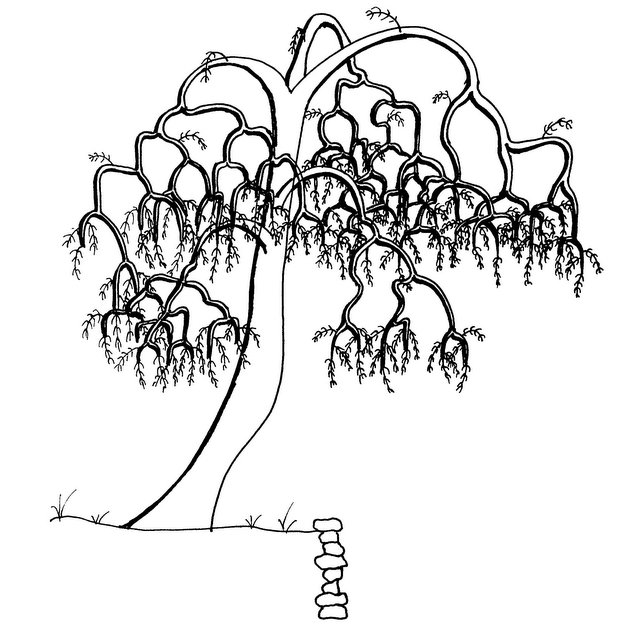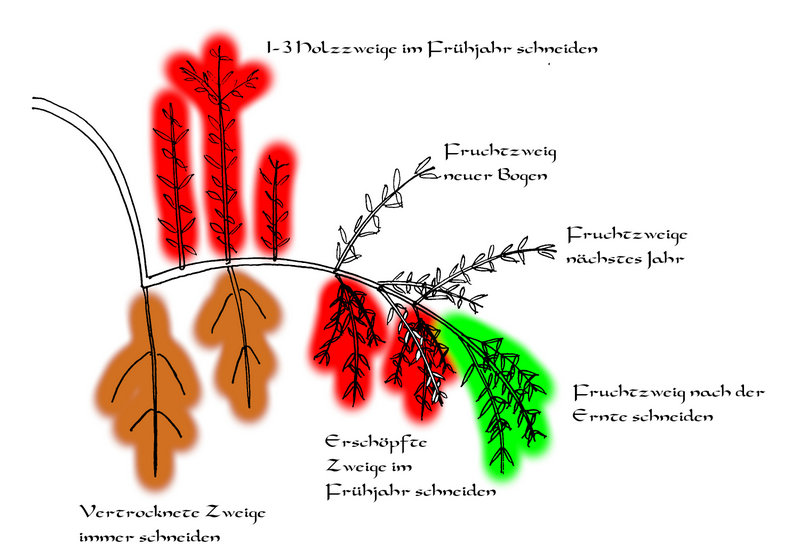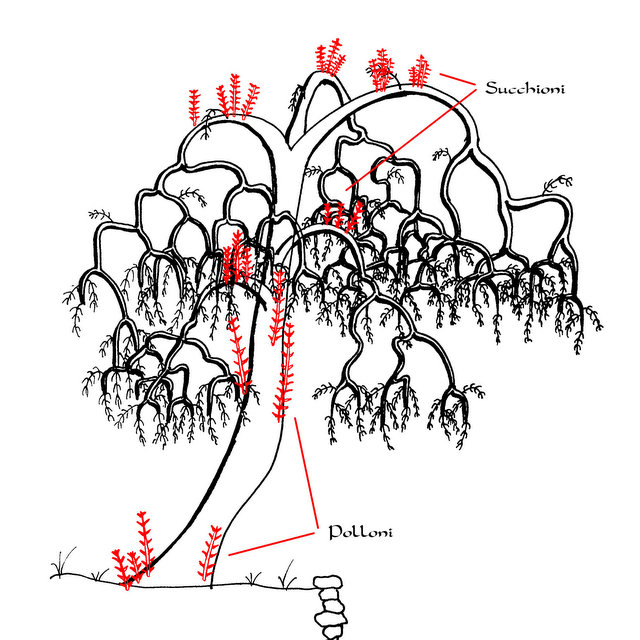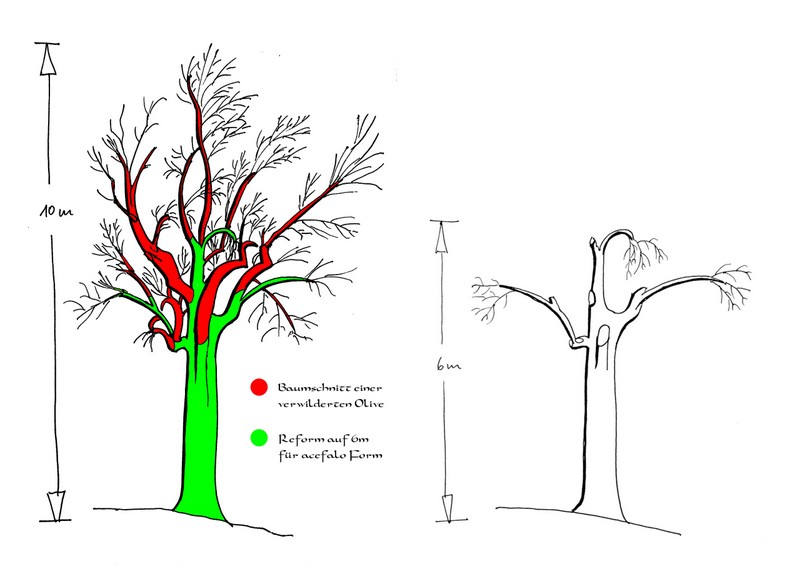General
A distinction is made between conservative cuts to preserve fertility, the green section to remove water shoots, and the reform section with which the tree is cultivated in accordance with the cultivation method.
We traditionally cut the acefalo (headless type). This form allows harvesting by hand with the Scalino (typical one-masted ladders). However, the method has the disadvantage that more water shoots grow than the modern polycono type. And of course more complex and less economical than the machine methods.

- The best time to conserve and reform cut is the end of winter before the plants expire, but at the latest before the trees start to bloom.
- The green cut will be done from the end of August when the trees are not drifting so much.
- In light pruning about 20% of the leaves are removed to optimize fruiting.
- An average intervention is 20-40% at which the shape is preserved.
- If more than 40% leaves are removed, this is an intensive reform cut. Usually to bring the tree back to the desired shape or to rejuvenate the tree thoroughly.
- Younger trees are cut only slightly to allow a good development and balanced fruiting. Older trees also tolerate intensive cutting very well.
The preservation section
With the preservation section, the branches can be renewed continuously and the fruits form uniformly over the years. This makes it possible to compensate for the alternating harvest (one year much, little next year).

- Tools used for the preservation cut are pruning shears, telescopic shears and folding saw.
- Always dry, broken and sick branches are removed.
- Second, the exhausted branches are removed to support the new fruit formation.
- Finally, one removes crossed or parallel and weak or shadowed branches.
- In this order you work your way down the tree from top to bottom. The larger cuts are made before the smaller cuts. One wants to avoid making unnecessary cuts to branches that are removed as a whole.
The green cut
The green cut takes place in the juice towards the end of the summer. It is intended to limit the formation of shoots and to reserve the forces of the tree for fruiting.

- There are two types of water shoots (also called spines) that should be removed.
- Polloni forming at the roots and along the trunk.
- Succhioni who shoot very fast vertically on the branches.
- Towards the end of August, when the formation of drift is less strong, the water shoots are cut. From September should not be cut more to give the tree rest for fruiting
The reform cut
The reform cut is the biggest intervention and must respect the age of the tree. The older the tree, the more radical the cut can be made. Here in the Campo we cultivate the olive trees to the traditional height of 5-6m. These high-stem olive trees can be well managed with a 13 sprout ladder.
Here is an example of a reform section of a wild Campo in which the trees have grown unchecked for several decades. In 3-4 years the typical acefalo form should result and the yield lansam should reach the usual amount of 15-25 kg.

- Tools used for the reform cut are a branch saw and a chainsaw.
- In a wild tree you have no clues on which you could reform the tree, as in a previously well cut tree even after 10-20 years is still possible.
- In order to reach a height of 5-6m, one looks for a side branch, which still carries foliage as inclined as possible in the appropriate height.
- If one looks down from above and looks in front of a three- or quadrilateral, one looks accordingly for 2-3 branches of the branches, which spread out until they still carry foliage.
- These now determined side branches lead one’s gaze back along the growth to the main branches.
- At the main branches you look for more inclined, foliage-carrying side branches that you want to leave standing.
- If all branches are determined to stop, you cut off everything else. Main branches and side branches, which grow only in height and which only have dried branches.
- As a rule, more than one person will be gone. If the tree is still too dense, clear it so that the branches do not overlap.
- Unfortunately, almost every year we have deaths and several injuries that fall from the tree or the ladder. The current safety rules must therefore be known to minimize the risk of accidents.
- The endangered area around the tree must be clarified by information or labeling.
- The Potatore (Tree Pruner) has to secure himself and his tools and aids.
- If large branches are sawn off, first the ditch must be cut free.
- Side branches that could get caught must be sawn off.
- To determine the direction of fall side branches are sawed off on the opposite side to the weight relief.
- For tall or large branches, proceed according to the felling technique and saw out a drop wedge.
- If necessary, secure the branch to be felled with a rope in order to control the fall direction.
Special
Cut There are other special cuts made on the olive tree, such as removing tree crabs or clearing the hollow trunk of decayed wood
- With the tree cancer the whole branch or branch can be removed. This is the safest method, but it can not be done in any case.
- If the tree crayfish has to be cut out, it is important to subsequently sterilize the tools in order to avoid transmission of the bacteria to healthy wood.
- The tool must be washed with fuel after the operation and then flamed. When flaming, care should be taken to heat from the back of the cutting tool to avoid tarnishing. Too much tarnishing or even annealing of the cut edges would destroy the hardness of the blades.
- If the trunk has to be cleared out, special tools have been developed over the centuries. Nowadays this is done with the chainsaw.
Literature / Links
Manuals via a simple and easy-to-read edition of ISP: 978-88-87652-16-1
http://www.giorgiopannelli.it/public/pdf/Potatura/Manuale%20potatura%20semplificata.pdf
AIPO. POTATURA> regole generali https://www.frantoiovalnogaredo.com/files/potatura.pdf
Pannelli G., Pandolfi S., 2007. Il controllo della produzione olivo mediante forma di allevamento e potatura. In: Storia della pota-tura. 7) Vaso dicotomico come riformarlo. Olivo e Olio, 2: 40-44.
http://www.liberapolis.it/wp-content/uploads/2013/07/Potatura7.pdf
Massimo Trebbi. Come ribassare un olivo http://myecomondo.blogspot.com/2011/11/come-ribassare-un-olivo.html
Giorgio Pannelli. Gli Olivi Monumentali http://www.associazioneaco.it/wp-content/uploads/2016/11/PDF-interno-light.pdf
Giorgio Pannelli. Il ritorno all’acefalia non ha futuro economico
And I still do so because of the manual harvest and the local tradition!
http://www.liberapolis.it/wp-content/uploads/2013/07/Potatura10.pdf
